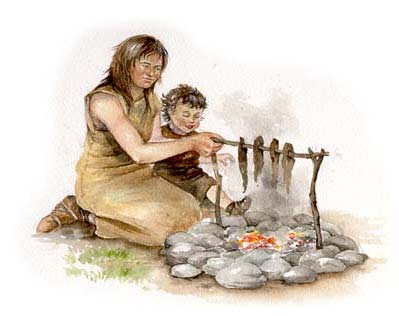The Land
The Land in Ancient Days
 When early man first settled here in pre-historic times the land was very
different. Bears, wolves and wild boar roamed the vast woodlands and the
rivers and coastline teemed with fish. It was the land of the Picts, the
natives of ancient Caledonia given that name by the Roman navigators who
explored the British coastline, from the Latin "Picti", "the
painted ones".
When early man first settled here in pre-historic times the land was very
different. Bears, wolves and wild boar roamed the vast woodlands and the
rivers and coastline teemed with fish. It was the land of the Picts, the
natives of ancient Caledonia given that name by the Roman navigators who
explored the British coastline, from the Latin "Picti", "the
painted ones".
Man built his religion on emotion, mythical tradition and superstition. He and his Druidical priests have long since gone but the relics of his mysterious worship still crown the tops of many local hill-tops. Christianity came to the North East sometime between AD 563 and 597 when the Irish monk, St Columba, converted Brude, the King of the ancient Picts at Inverness before heading east to continue his work.
 Though many ancient relics were destroyed when the land was cleared for
farming in the 1700s, the area is still scattered with the remains of hundreds
of stone circles and Pictish and Christian carved stones. At Castle Point,
near Pennan, archaeologists found evidence of a Bronze age settlement,
an Iron Age settlement and the remains of a Pictish fort. With steep sea
walls on three sides and narrow access from land, the little headland provided
a safe haven for its inhabitants.
Though many ancient relics were destroyed when the land was cleared for
farming in the 1700s, the area is still scattered with the remains of hundreds
of stone circles and Pictish and Christian carved stones. At Castle Point,
near Pennan, archaeologists found evidence of a Bronze age settlement,
an Iron Age settlement and the remains of a Pictish fort. With steep sea
walls on three sides and narrow access from land, the little headland provided
a safe haven for its inhabitants.
The Monks of Deer. . . . The earliest records of land transactions in the
North East were discovered in the Book of Deer, a Gospel Book written c900,
which was in the possession of the Cistercian monks at the Abbey of Deer
c1100 AD. Notes in the margins of the book which refer to local land gifted
to the church were written in Gaelic probably in the middle of the twelfth
century. The first item provides an origin-legend for a monastery at Aberdour
and for the older monastery at Deer. The land had been given to Columba
by the Pictish chief, Bede.
 The scribes who undertook the work of writing the Gospel Manuscripts looked
upon their task as an act of faith, similar to prayer.
The scribes who undertook the work of writing the Gospel Manuscripts looked
upon their task as an act of faith, similar to prayer.
The feudal system was introduced into Scotland during the eleventh or twelfth century and continued in existence for over 500 years. Tenants held their lands on condition that they should be ready to follow their landlord to battle whenever he required their services and, as peace never lasted long in those days, the tillers of the soil were liable at any moment to be summoned to the field. Few of them possessed any capital and it was customary for landlords to provide their tenants with seed-corn and a certain number of horses and cattle, on condition that half of the produce should be given to the superior. With no artificial drainage, much of the land was wet and unproductive. Green crops and stall-feeding were unknown. When farming improvements began in the early 1700s the North East was very much to the fore. Drains were dug turning marshland into meadows and the immense task of clearing the land of stones began. In some places the stones were so dense that “consumption” dykes were built, literally to “consume” the vast quantities of stones. The improvements of the seventeen and eighteen hundreds brought about a drastic change in the North East landscape. Land that had looked the same for thousands of years was changed in a hand full of generations into rich and fertile land capable of sustaining intense crop and cattle farming.

